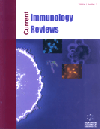- Home
- A-Z Publications
- Current Immunology Reviews (Discontinued)
- Previous Issues
- Volume 3, Issue 1, 2007
Current Immunology Reviews (Discontinued) - Volume 3, Issue 1, 2007
Volume 3, Issue 1, 2007
-
-
Editorial
More LessBy David D. LoWe begin another year much as the last, but with continued momentum. As we noted in last year's comments, our goal is to provide review articles that furnish new perspectives to bridge the gap between basic immunology and clinical application. Our particular focus is to arrange reviews covering specific application of research in basic mechanisms to the understanding of complex clinical diseases, and to highlight areas i Read More
-
-
-
Regulation of Protective and Pathogenic Th17 Responses
More LessAuthors: Gottfried Alber and Thomas KamradtThe recent description of a T helper lymphocyte subset (Th17) that is characterized by the production of IL-17, TNF-α , IL-6, IL-22, and GM-CSF has substantially influenced current concepts of the pathogenesis of inflammatory diseases such as arthritis or encephalitis. Contrasting with the prevailing dogma that held IFN-γ producing Th1 cells responsible for the pathogenesis of most organ-specific autoimmune diseases it ha Read More
-
-
-
Dendritic Cells: More Than Just Adaptive Immunity Inducers?
More LessAuthors: Nathalie Jacobs, Jacques Boniver, Pascale Hubert and Philippe DelvenneDendritic cells (DC) are well known for their capacity to induce immune responses and there is also accumulating evidence of their ability to interact with various cell types of the innate system, such as NK, NKT or TCRγδ cells. These interactions are bi-directional, mediated by soluble or cell surface molecules and have been mainly described in the context of immune responses to infectious agents and tumors. NK, NKT or Read More
-
-
-
Signal Transduction of the Aging Innate Immune System
More LessAuthors: Christian R. Gomez, Vanessa Nomellini, Eric D. Boehmer and Elizabeth J. KovacsAging is associated with defects in the cells of the innate immune system, in both their function and number. During the last decade, new evidence has revealed impairment in the early stages of the activation processes that trigger innate immune cells. In this review, the impact of aging on signal transduction in macrophages (MΦs), as pivotal representatives of innate immunity, is presented. Emphasis is put on the classical i Read More
-
-
-
Host-Cell Survival and Death During Chlamydia Infection
More LessAuthors: Songmin Ying, Matthew Pettengill, David M. Ojcius and Georg HackerDifferent Chlamydia trachomatis strains are responsible for prevalent bacterial sexually-transmitted disease and represent the leading cause of preventable blindness worldwide. Factors that predispose individuals to disease and mechanisms by which chlamydiae cause inflammation and tissue damage remain unclear. Results from recent studies indicate that prolonged survival and subsequent death of infected cells and t Read More
-
-
-
Myeloma Cells and Their Interactions With the Bone Marrow Endothelial Cells
More LessMultiple myeloma (MM) is an incurable plasma cell malignancy characterized by a monoclonal proliferation of plasma cells in the bone marrow (BM), secretion of paraprotein in serum, development of osteolytic bone lesions and angiogenesis in the BM. In the BM, MM cells receive signals to survive and proliferate due to the existence of functional, mutual interactions between the MM cells and the BM stromal cells. This strom Read More
-
-
-
In Vitro Models of Human T Cell Development: Dishing Out Progenitor T Cells
More LessAuthors: Ross N. La Motte-Mohs, Geneve Awong and Juan Carlos Zuniga-PfluckerT cells develop within the unique microenvironment provided by the thymus. T cell differentiation involves a series of commitment events and developmental checkpoints including T cell receptor (TCR) gene recombination and positive/negative selection of developing thymocytes to yield functionally mature T cells. These events occur in a sequential, temporal and spatial fashion, as developing thymocytes migrate through Read More
-
-
-
Current Understanding of the Role of Dendritic Cells and Their Co-Stimulatory Molecules in Generating Efficient T Cell Responses in Lepromatous Leprosy
More LessLeprosy is a chronic infectious disease caused by Mycobacterium leprae that needs continued vigilance, particularly for detection and treatment of hidden and undiagnosed cases. Cell-mediated immunity in leprosy has been identified as a key mechanism for the understanding of this disease. The dendritic cell (DC) is the most potent professional antigenpresenting cell and recently has been the focus of much interest as the m Read More
-
Volumes & issues
Most Read This Month
Article
content/journals/cir
Journal
10
5
false
en


